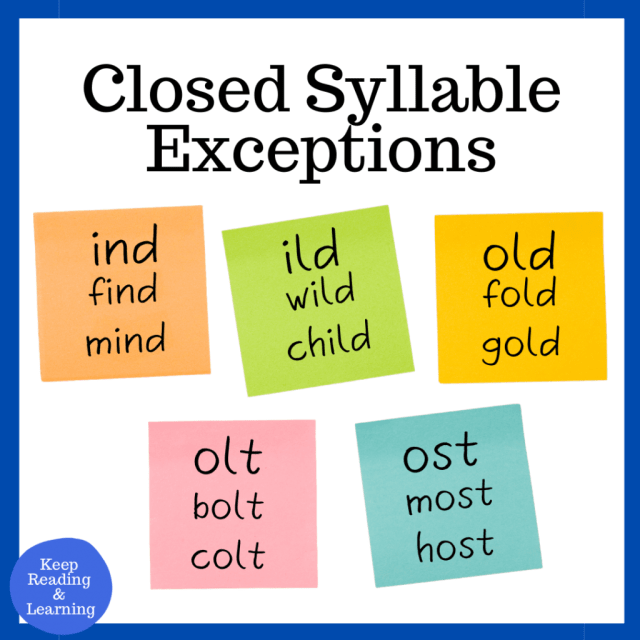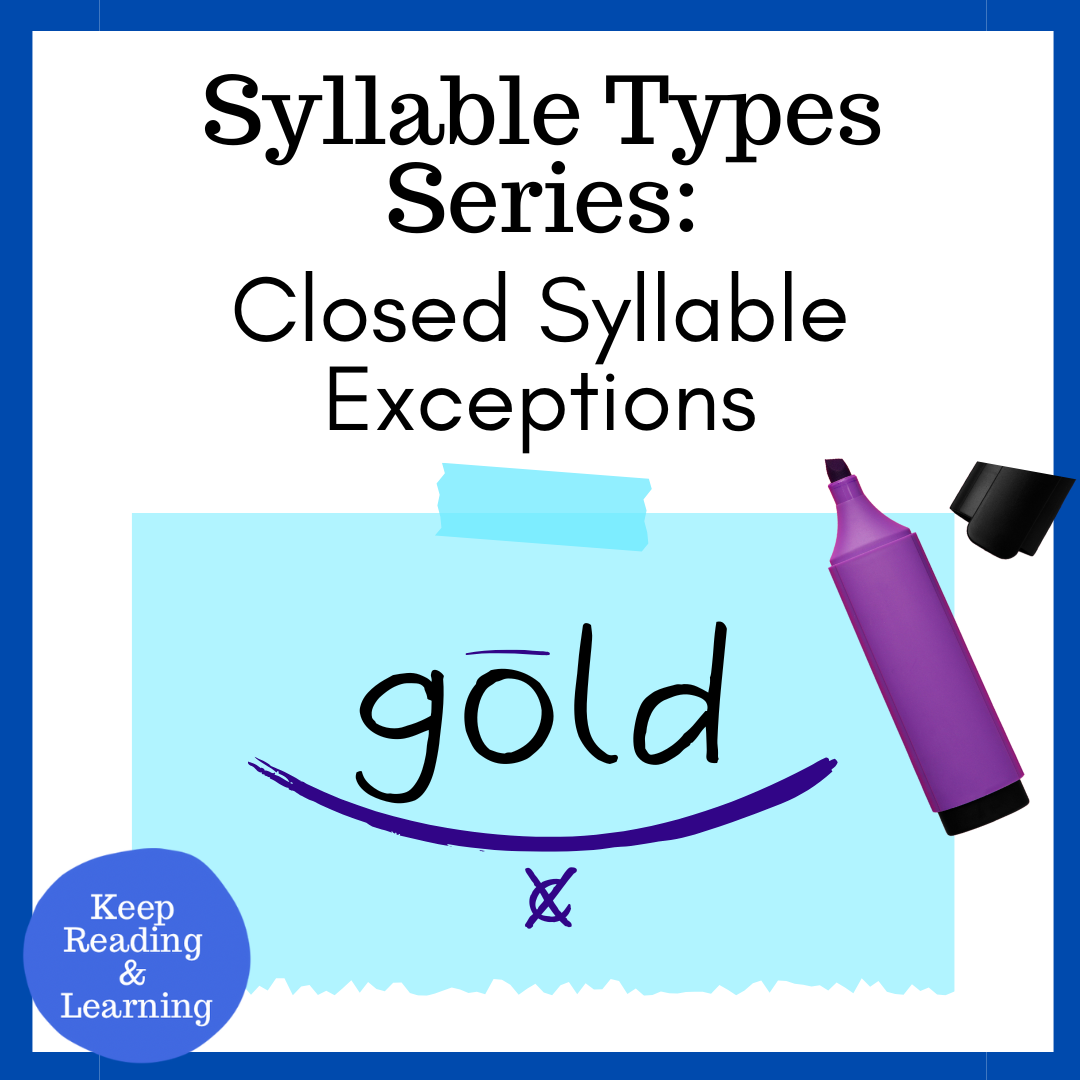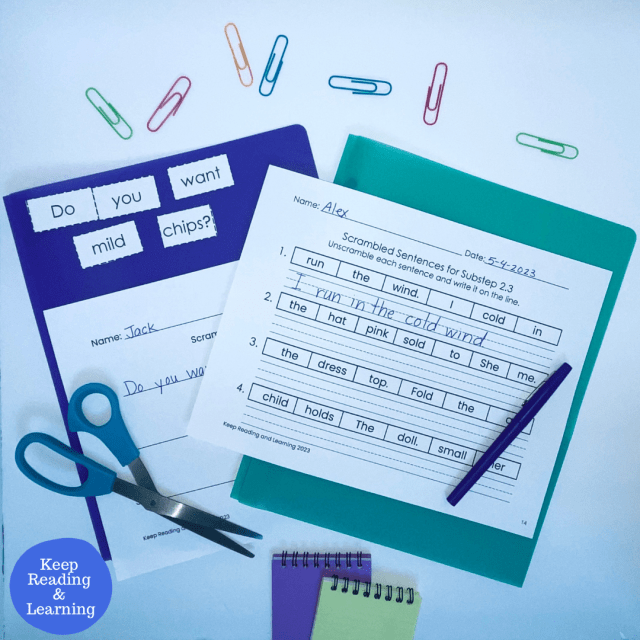Ever had a student puzzled by the vowel sound in a word like find or post? Maybe they’ve asked why these words don’t “follow the rules,” leaving you searching for an answer! Here’s the secret: find and post are closed syllable exceptions! By the end of this blog, you’ll feel equipped and ready to explain these tricky words with confidence.
This is the second post in my Syllable Type Series. I chose to start this blog series with closed syllables and closed syllable exceptions because the closed syllable is English’s most common syllable type. According to Reading Rockets, just under 50% of English syllables are closed.

This post contains affiliate links.
Have you heard that we shouldn’t waste time teaching the six syllable types?
There’s research to support the inclusion of these concepts in our instruction. Each syllable type has spelling conventions that help students read and spell words, including multisyllabic words that include more than one type of syllable. Reading Rockets explains that “Familiarity with syllable patterns helps students to read longer words accurately and fluently and to solve spelling problems.”
Additionally, Blachman, et al (1999) report that “First graders directly taught the six syllable types outperformed their peers who received implicit phonics instruction on measures of reading and spelling.”

Not convinced yet? Reed (2012) asserts that “learning the six syllable types also enables students to encode sounds, such as r-controlled vowels and consonant-le, that take more than individual letters to produce.”
While it’s true that some learners may be overwhelmed by the cognitive load of learning all the nuances of each syllable type, we can tailor our instruction to the students in front of us. Having a basic knowledge of the syllable types and common spelling patterns is beneficial both to you as the instructor and to your students, the budding readers and spellers.
Before you dive into closed syllable exceptions…
To understand closed syllable exceptions, both you and your students need a solid understanding of closed syllable rules. You can brush up by reading the first post in the Syllable Type Series. Here’s a simplified explanation of closed syllables: A closed syllable has one vowel that is “closed in” by one or more consonants. The vowel represents the short sound because it is closed in.
As for your students, your phonics instruction should allow them to develop the ability to accurately and automatically read closed syllable words with blends like brush and bend before you address closed syllable exceptions. Without this foundation in closed syllables, the exceptions may be confusing!
Let’s get to it: What are closed syllable exceptions?
Closed syllable exceptions are when the vowel in a closed syllable unexpectedly represents the long sound instead of the short sound. Consider the word find. The single vowel is “closed in” by n and d. According to closed syllable rules, the i should represent its short sound, but instead, it represents the long sound. Here are five word families that demonstrate the closed syllable exceptions:
- ind: find, bind, hind
- ild: wild, child, mild
- old: gold, fold, mold
- olt: jolt, volt, molt
- ost: most, post, ghost

It’s important to know that these word families do not always represent closed syllable exceptions, so the vowels do not always represent their long sounds. According to Uncovering the Logic: A Common-Sense Approach to Reading, Spelling, and Literacy of English by Denise Eide (2012), “i and o may say ī and ō when followed by two consonants.” (That horizontal line above the i and the o indicate that they are the long sounds!)
Eide is careful to point out that these vowels may represent the long sound when followed by two consonants but they will not always represent the long sound when followed by two consonants. Think of the word cost, which uses the short o sound and post, which uses the long o sound. The word wind can be pronounced both ways: you can wind up a yoyo or watch your kite move in the wind.

Spelling and Reading Words with Closed Syllable Exceptions
Fortunately, closed syllable exceptions are quite easy to spell! Most students who have achieved accuracy in spelling closed syllables will also spell the exceptions with ease. You may encounter a student who adds a silent e to the end in an attempt to explain why the vowel sound is long, but teaching them the closed syllable exception rule from Logic of English will help clarify.
What about reading closed syllable exceptions accurately? It might get tricky! Your students need to know which word families may be closed syllable exceptions, and they need an adequate oral vocabulary.
What does a student’s oral vocabulary have to do with reading closed syllable exceptions correctly?
If the student has heard or spoken a word before, they are more likely to recognize it in print.
Let’s think about the word hind. It’s probably not a word your students read or speak often. When they first encounter it in print, they may pronounce it with a short i sound. However, if the student has been exposed to the phrase hind legs when talking about an animal, they may quickly revise their pronunciation. If they read the word in the context of a sentence like Scruffy broke his hind leg, chances are even higher that they will combine their vocabulary skills, comprehension skills, and background knowledge to revise their pronunciation.

There’s even a name for this phenomenon: set for variability. Set for variability is a skill that helps students determine if they have pronounced a word correctly. Steacy, et al (2019) describe set for variability as “a child’s ability to address the mismatch between decoded form and stored word pronunciation.” Set for variability is strengthened by a strong oral vocabulary. If a reader has a word in their oral vocabulary, they are much more likely to read that word correctly when they encounter it in print.
Do you need materials to help you teach the closed syllable exceptions?
You won’t regret investing in this bundle of resources, which includes 22 different activities and 37 student pages to practice reading and spelling words with closed syllable exceptions at the word, sentence, and passage levels.
The decodable passages (included in the bundle) have been a consistent top seller since 2022. They have 4.9 stars based on 17 reviews! Teachers who were kind enough to leave reviews shared that their students found the stories engaging, the materials were low-prep, and their students got the extra practice they needed with this tricky rule.
Michelle R. said, “I was struggling to find a passage that was appropriate for my students that allowed them to practice the closed syllable exceptions. This was perfect.”
If you’re using Wilson, Fundations, Just Words, or a similarly structured phonics program, most of the materials in this unit will be decodable for your students!
The worksheets and activities include:
- Word-building cards for hands-on reading and spelling
- Sound mapping boxes for high-frequency words with closed syllable exceptions from the Dolch and Fry lists. This activity promotes orthographic mapping of high-frequency words.
- 3 options for decodable sentence reading, each with different sentences.
- Unscrambling sentences with closed syllable exceptions. Sentence unscrambling activities help students understand the concept of a complete sentence, improve their knowledge of syntax (word order), and successfully incorporate capitals and punctuation.
- Word and sentence dictation allows you to collect data on your students’ spelling mastery.
- 3 decodable text passages that maintain a 4.9 star rating!
- Introductory worksheets for each passage to teach selected vocabulary and high frequency words
- Vocabulary flashcards to review the meanings of important words in the passages
- Fill-in-the-blank worksheets for each passage
- Writing assignments for each passage
- Multiple-choice reading comprehension quizzes for each passage
- Teacher-led oral reading comprehension checks for each passage
Don’t need that many materials? Snag a smaller product!
Scrambled Sentences
If you’ve been with me for a couple of years, you know how much I love scrambled sentences! According to the authors of The Writing Revolution, unscrambling sentences helps students:
- understand the concept of a complete sentence
- improve their knowledge of word order
- successfully incorporate capitals and punctuation
When you use sentences aligned with your phonics program, your students get all the benefits listed above, plus the opportunity to work with decodable text, which helps develop fluency. That’s why I created decodable scrambled sentences!
You can use the no-prep worksheet version if you’re short on time. Looking for a more hands-on experience? Cut up the sentences, which allows your students to move the words around and experiment with ways to make a complete sentence. With 28 sentences included, you’ll have plenty of materials for independent work or your literacy centers.
Sentence Level Practice
You’ve taught your students to read and spell closed syllable exceptions at the word level, and now it’s time to help them develop their fluency as they read these words in sentences! These sentence level activities offer your students ample opportunities to read sentences that include closed syllables, closed syllable exceptions and a controlled number of high frequency words.
- Student Reader Pages: Students read from a list of sounds, words, and then sentences that include closed syllable exceptions. You can laminate the sheets, keep them in sheet protectors, photocopy them, or have students glue them in their notebooks.
- Read and Draw: This one was a favorite in my special education groups last year! Students read five sentences and then choose one to illustrate to demonstrate their comprehension. Students will also find and write down four words from the sentences that have closed syllable exceptions.
- Sentence Cards for Centers or Independent Work: Print these sentences on colorful cardstock, laminate them, and bind them with a book ring. Now they are long-lasting centers materials for practicing sentence fluency!
- Roll & Read Game: One option is for independent work and one is for two players. Consider laminating the pages and having students mark with dry-erase markers.
Decodable Passages
I’ve heard from many teachers that their reading program covers word and sentence-level learning, but they don’t have enough decodable passages that address closed syllable exceptions. If you need more stories, here is your solution!
As I mentioned above, these stories have consistently been in my top-selling resources since 2022 and reviews like this one from Melynda E. tell you why: “This is a great passage with a very engaging story… It was a wonderful way to practice the olt/old/ild words.”
Teachers loved this product when it was just the stories, but now there’s so much more! The summer 2024 update took each reading comprehension passage and turned it into a week’s worth of engaging, effective lessons! Included for each passage are:
- an introductory worksheet to teach selected vocabulary and high frequency words
- vocabulary flashcards to review the meanings of important words in the passages
- a fill-in-the-blanks worksheet
- a writing assignment
- a multiple-choice reading comprehension quiz
- a teacher-led oral reading comprehension check
Planning your small group instruction has never been easier!






